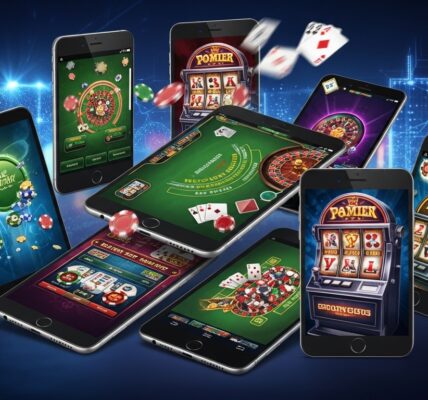Introduction
Gaming has evolved into one of the most powerful entertainment industries in the world. What began as a simple pastime, with blocky graphics and limited sound effects, has become an immersive experience that blends storytelling, technology, and art. From arcade machines in dimly lit rooms to virtual reality adventures in living rooms, the journey of gaming is a fascinating reflection of human creativity and technological progress.
In this blog, we’ll explore how gaming has transformed over the decades, how it impacts society, the psychology behind why people play, and what the future holds for gamers and developers alike.
The Birth of Gaming
The roots of gaming can be traced back to the mid-20th century when engineers and computer scientists began experimenting with interactive technology. The earliest examples were simple electronic games like “Tennis for Two” and “Spacewar!” which paved the way for arcade classics in the 1970s.
The 1972 release of Pong by Atari marked a major turning point. It was a simple two-dimensional tennis game, yet it captured the imagination of millions. For the first time, people could interact with a television screen, not just watch it. This marked the beginning of gaming as a form of entertainment, not just a technical curiosity.
By the late 1970s and early 1980s, arcades were the beating heart of gaming culture. Games like Pac-Man, Donkey Kong, and Space Invaders became global phenomena. These games didn’t have complex narratives or cinematic visuals, but they offered something powerful — fun, competition, and community.
The Rise of Home Consoles
As technology advanced, gaming started to move from arcades to homes. The introduction of consoles like the Atari 2600, Nintendo Entertainment System (NES), and Sega Genesis revolutionized the way people interacted with games.
In the 1980s, the NES became a household name. It brought characters like Mario, Link, and Samus into the cultural spotlight. For the first time, games were not just about scores but about stories. Titles like The Legend of Zelda and Metroid introduced worlds that players could explore and conquer, setting the stage for narrative-driven gaming.
The 1990s saw intense competition between gaming giants. Nintendo and Sega fought fiercely for dominance, each trying to outdo the other in graphics, gameplay, and innovation. This era gave rise to beloved franchises such as Sonic the Hedgehog and Super Mario World.
The 3D Revolution
One of the most significant leaps in gaming history occurred in the mid-1990s with the arrival of 3D graphics. The introduction of the Sony PlayStation, Nintendo 64, and Sega Saturn transformed how games looked and felt. Players could now move through fully rendered environments, creating a new sense of freedom and immersion.
Games like Super Mario 64, Final Fantasy VII, and Tomb Raider showcased what was possible with this technology. These titles didn’t just change how games were played — they changed how stories were told. The cinematic approach of Final Fantasy VII, with its emotional narrative and memorable characters, demonstrated that video games could be just as moving as films or books.
This era also marked the rise of the gaming soundtrack. Music became an integral part of the experience, enhancing emotional moments and creating unforgettable memories. Who can forget the sweeping score of The Legend of Zelda: Ocarina of Time or the haunting melodies of Silent Hill?
The Online Gaming Revolution
As the new millennium approached, gaming took another massive step forward — the internet became part of the experience. Multiplayer gaming, once limited to two players sitting on the same couch, expanded into vast online communities.
The late 1990s and early 2000s saw the rise of online platforms like Xbox Live and PlayStation Network. Players could now connect, compete, and cooperate with others across the globe. Titles like Halo 2, World of Warcraft, and Counter-Strike became cultural landmarks.
Online gaming wasn’t just about competition; it was about connection. Friendships were formed across continents, and online identities became as meaningful as real-world ones. Gaming chat rooms, clans, and guilds turned virtual spaces into vibrant social hubs.
The Emergence of Mobile Gaming
The 2010s introduced another revolution — gaming on the go. Smartphones transformed the industry by making games accessible to everyone, everywhere. Games like Angry Birds, Clash of Clans, and Candy Crush Saga reached audiences far beyond traditional gamers.
Mobile gaming democratized the medium. It didn’t require expensive consoles or PCs; all one needed was a phone. The accessibility led to a massive expansion of the gaming audience, including people who had never considered themselves gamers before.
In addition, mobile gaming blurred the line between casual and hardcore play. Titles like PUBG Mobile and Genshin Impact proved that mobile platforms could deliver high-quality, immersive experiences once reserved for dedicated gaming systems.
Gaming as an Art Form
Today, gaming is recognized as a legitimate art form. It combines visuals, sound, storytelling, and interactivity in ways that no other medium can. Developers have become storytellers, directors, and artists all at once.
Games like The Last of Us, Journey, and Red Dead Redemption 2 show how emotional and profound interactive storytelling can be. These titles are not just about gameplay; they are about human experience — loss, love, survival, and identity.
The artistry of gaming extends beyond visuals. It includes voice acting, motion capture, musical composition, and even player choice. Every decision in a game can change the story, making the player a co-author.
The Psychological Power of Gaming
Gaming is more than entertainment; it’s a psychological experience. Players engage with games for different reasons — challenge, relaxation, creativity, or social connection.
Research has shown that gaming can improve cognitive skills such as problem-solving, spatial awareness, and multitasking. It can also reduce stress and anxiety when played in moderation.
The sense of achievement that comes from completing a difficult level or mastering a complex strategy can boost confidence. For many, gaming provides a safe escape from the pressures of everyday life — a space where they can express themselves freely.
However, gaming also has its challenges. Issues like addiction, toxic behavior, and excessive screen time have sparked debate. The key lies in balance — enjoying games as part of a healthy lifestyle.
The Rise of Esports
Esports has transformed gaming into a spectator sport on a global scale. Competitive gaming events now fill stadiums, attract millions of viewers online, and offer prize pools worth millions of dollars.
Games like League of Legends, Dota 2, and Counter-Strike: Global Offensive have become the cornerstone of this digital sports revolution. Professional players train rigorously, form teams, and compete in organized tournaments watched by fans worldwide.
Esports has also created new career paths. Streamers, commentators, analysts, and content creators now make a living through gaming. Platforms like Twitch and YouTube Gaming have given rise to a new generation of influencers who entertain and inspire millions.
The Role of Storytelling in Modern Games
In modern gaming, storytelling has become as important as gameplay. Developers craft intricate worlds filled with lore, characters, and moral choices that engage players on a deep emotional level.
Games like God of War, Cyberpunk 2077, and Elden Ring have shown how storytelling can be both interactive and cinematic. Players aren’t just passive viewers; they’re participants who shape the outcome.
This interactive storytelling allows games to explore complex themes like morality, identity, and destiny. Players often find themselves reflecting on the decisions they make in the game, blurring the line between virtual and real emotions.
The Social Impact of Gaming
Gaming is no longer a solitary activity. It’s a social ecosystem that connects millions of people across cultures and generations. Online multiplayer games and social platforms within games have become spaces for friendship, teamwork, and community building.
Games like Fortnite and Minecraft are prime examples. They serve not just as games but as virtual meeting places where people can collaborate, create, and socialize.
Gaming also has a positive impact on education and learning. Educational games teach subjects like math, science, and history in engaging ways. Simulation games help players develop real-world skills such as resource management, creativity, and leadership.
The Future of Gaming: Virtual and Augmented Reality
The future of gaming is even more exciting. Technologies like virtual reality (VR) and augmented reality (AR) are pushing boundaries of immersion and interaction. VR headsets transport players into lifelike environments, while AR overlays digital elements onto the real world.
Imagine exploring ancient ruins in full 3D detail, fighting dragons in your living room, or working out in a game that feels like a cinematic adventure. These possibilities are no longer dreams — they’re becoming reality.
Artificial intelligence is also shaping the future of gaming. AI-driven characters can adapt to player behavior, creating unique experiences for every individual. Meanwhile, procedural generation allows developers to create vast, dynamic worlds that evolve over time.
Gaming and the Metaverse
Another major development in the gaming landscape is the concept of the metaverse — a shared digital universe where people can live, work, and play. Games like Roblox and Fortnite are already pioneering this vision, blending social interaction, creativity, and virtual economies.
In the metaverse, gaming could become more than entertainment; it could be an extension of life itself. Players might attend concerts, build businesses, or even earn real income through digital worlds. The boundaries between game and reality continue to blur, raising fascinating questions about identity and existence in the digital age.
The Cultural Influence of Gaming
Gaming has permeated every aspect of culture — from movies and music to fashion and sports. Characters like Mario, Lara Croft, and Master Chief have become pop culture icons.
Game-inspired films and series are becoming more common, and esports events rival traditional sports in viewership. Merchandise, cosplay, and fan art demonstrate the deep emotional connections people have with their favorite games.
Moreover, gaming has given a voice to diverse communities. Independent developers use games to tell stories that mainstream media often overlooks, exploring themes of culture, identity, and social justice.
The Business of Gaming
The gaming industry has become one of the most profitable sectors in entertainment, surpassing even film and music combined. Game development has evolved into a complex ecosystem involving designers, writers, programmers, artists, and marketers.
Monetization models have also changed dramatically. Once, players bought physical cartridges or discs. Now, digital downloads, subscriptions, and in-game purchases dominate. Free-to-play games have proven that accessibility can coexist with profitability, though they’ve also sparked debates over microtransactions and fairness.
The rise of indie games has democratized development. Small teams or even individuals can now create and publish their own games, thanks to accessible tools and digital distribution platforms. Many of these indie titles offer fresh ideas and emotional depth that rival big-budget productions.
The Emotional Connection Between Players and Games
One of the most remarkable aspects of gaming is the emotional bond players form with the worlds they explore. A great game can make players laugh, cry, or reflect on their own lives.
The sense of immersion allows players to step into someone else’s shoes, experience different perspectives, and make choices that carry moral weight. Games like Life is Strange or Undertale challenge players to think about empathy and consequence.
This emotional engagement is why gaming continues to grow in popularity. It offers something that no other medium can — the ability to live another life, even if just for a few hours.
Conclusion: The Infinite Game
Gaming has come a long way from its humble beginnings. It has evolved from pixels to photorealism, from simple mechanics to complex narratives, from isolated players to global communities.
At its core, gaming is about human connection — the connection between player and world, between imagination and reality, between people across continents. It is a space where technology meets emotion, where creativity thrives, and where possibilities are endless.
The future of gaming is not just about better graphics or faster consoles. It’s about expanding what it means to play, to imagine, and to connect. As technology continues to advance, gaming will remain at the forefront of cultural and creative innovation.
In the end, gaming isn’t just something we do. It’s part of who we are — a reflection of our endless curiosity, our desire for adventure, and our need to connect through stories that only games can tell.





